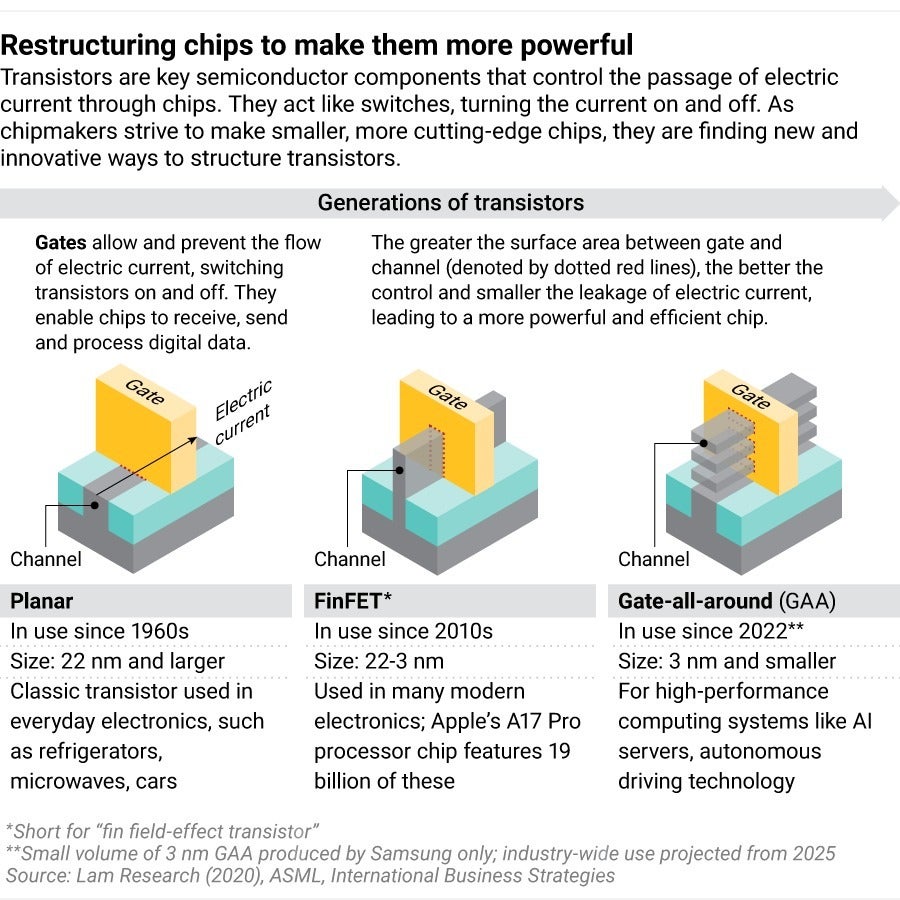

Source — Nikkei Asia.
Major players in the chip industry and the road so far
There are currently three leading manufacturers in the chip industry and those are Intel (U.S.), TSMC (Taiwan), and Samsung (South Korea). There is also the Chinese company SMIC, but it is lagging behind the rest of the pack and is about two generations behind for the moment.
The three leading manufacturers mentioned above have all been pushing strongly to advance chips with the more significant leaps starting in the 2000s. Here’s a quick overview starting with 2013 up until now, the year we are in at the moment, and what to look forward to in the near future.
Top row has the year, with the corresponding transistor gate width measured in nanometers below. The empty spaces represent no newly released generation for that year.


“*” stands for “expected” as the information is yet to become official.


“*” stands for “expected” as the information is yet to become official.
You can probably tell for yourself that throughout the years, the nanometers have been steadily decreasing by about half of the previous generation’s size. In other words, the number of transistors included in a chip has been doubling, and a closer inspection reveals that it has consistently taken the industry roughly a couple of years to go to the next stage.
Moore’s Law: A misleading term
The consistently similar amount of time it takes manufacturers to jump from one generation to the next in a chip’s evolution is no coincidence. In fact, Intel co-founder Gordon Moore himself stated as early as 1965 that every eighteen months the number of transistors inside chips will double, which nowadays is known as Moore’s Law.This tendency in chip evolution has remained true for so long now, that it almost seems like we are talking about a natural law, one that doesn’t change no matter the circumstances. But the truth is different. Moore presented his thoughts on the subject as a mere observation and not a “law”. In fact, he did not foresee his prediction to continue any more than a single decade.
It is nothing short of impressive that Moore’s observation has continued to be true throughout all of these years, but there are physical limitations to how long this can continue.
Current transistors are made out of silicon, and a silicon atom is 0.2nm in size. In other words, even if we do manage to continue shrinking transistors, we cannot make them any smaller than that.
Visual aid for nanometer measurement
Before we continue talking about nanometer this and nanometer that, it is probably best if we first understand how big a nanometer actually is. Now, just like it is difficult for a human brain to grasp the size of the universe, so it is to understand the size of one nanometer, but the following examples should put things into perspective (and will likely blow your mind).
Are we nearing the end of chipset evolution?
So the natural question to ask ourselves is whether chip innovation will come to a halt, or if there are other avenues the chip industry can turn to. Well, thankfully, there’s always a way to grow and make a product better. Here are a few glimpses into the future of computing.
Advanced chip packaging
Advanced chip packaging refers to stacking multiple chips onto wafers, which can help achieve levels of performance said to be comparable to chips made on the 5 or even the 3nm process.
This method is also less expensive, as it does not require the same amount of precision and delicate equipment necessary for shrinking transistors.
Popular companies such as Intel and Nvidia have already implemented this method into their latest chipsets.
Making transistors out of a different element
So, as we have already established, transistors are made out of silicon. There’s a reason we have the so-called Silicon Valley in California. But as we stated earlier, silicon can only take us so far before we reach its limitations.One example is gallium. Now, gallium’s atomic radius is not smaller than that of silicon so you cannot fit more transistors made out of it. Gallium Nitride, however, produces less heat, which means there is less cooling required to keep them at maximum performance.
This is just one example though. There are other materials manufacturers can experiment with to achieve better results from a chip.
Quantum computing
Another road we can take to continue increasing our technological horsepower is quantum computing. Quantum computers have the potential to help us delve into completely new territories, but the chances that they will power our phones anytime in the future are extremely slim as they require extreme cooling (15 millikelvin to be exact, which is colder than outer space), which in itself requires very complex and large components.So, in other words, quantum computing is an option, just not one that would affect mobile tech in a meaningful way. At least not for the foreseeable future.
#Pushing #limits #nanometer #plateau #future #phone #chipsets


